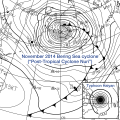Cyclone
In meteorology, a cyclone refers to any low pressure area with winds spiraling inwards. Cyclones rotate clockwise in the Southern Hemisphere and anti-clockwise in the Northern Hemisphere. A cyclone is the general term for a variety of low pressure system types, such as tropical cyclones, extra tropical cyclones and tornadoes.
The largest of these systems are extratropical cyclones and cold-core polar cyclones which lie on the synoptic scale with a horizontal length of 1000 km or more. The warm-core cyclones are the tropical cyclones, mesocyclones, and the polar lows that lie within the smaller mesoscale. Subtropical cyclones are intermediate in size. Cyclones have also been on other planets outside of Earth, such as the Great Red Spot of Jupiter and the Great Black Spot of Neptune.
Cyclones are also referred to as hurricanes and typhoons (depending where do they form). They consist of the eye, eyewall and rainbands.
The process of cyclone formation and intensification is described as cyclogenesis. The formation of extratropical cyclones comes as waves in large regions of enhanced midlatitude temperature contrasts which are called baroclinic zones. These zones contract to form weather fronts as the circulation of the cyclone closes and gets more intense. Later in their life cycle, cyclones form what is called an occluded front. The cyclone's track is then guided over the course of an 2 to 6 day life cycle by its steering flow of the polar or subtropical jetstream. Cyclones destroy many things when they come into contact with land such as crops, buildings, trees, etc.
Cyclone Media
The initial extratropical low-pressure area forms at the location of the red dot on the image. It is usually perpendicular (at a right angle to) the leaf-like cloud formation seen on satellite during the early stage of cyclogenesis. The location of the axis of the upper level jet stream is in light blue.
Tropical cyclones form when the energy released by the condensation of moisture in rising air causes a positive feedback loop over warm ocean waters.
A fictitious synoptic chart of an extratropical cyclone affecting the UK and Ireland. The blue arrows between isobars indicate the direction of the wind, while the "L" symbol denotes the centre of the "low". Note the occluded, cold and warm frontal boundaries.
A polar low over the Sea of Japan in December 2009
Subtropical Storm Alex in the north Atlantic Ocean in January 2016
Hurricane Florence viewed from the International Space Station
Cyclone on Mars, imaged by the Hubble Space Telescope
Other websites
 Media related to Astronaut images of tropical cyclones at Wikimedia Commons
Media related to Astronaut images of tropical cyclones at Wikimedia Commons
| Cyclones and Tropical cyclones of the World |
|---|
| Cyclone - Tropical - Extratropical - Subtropical - Mesocyclone - Polar cyclone - Polar low |









